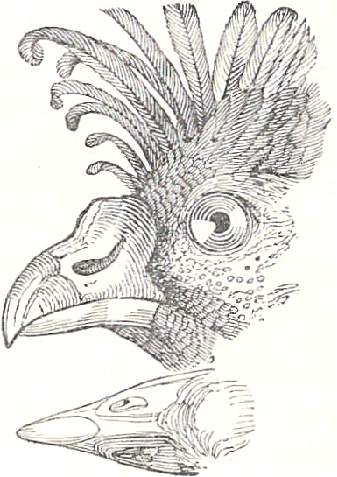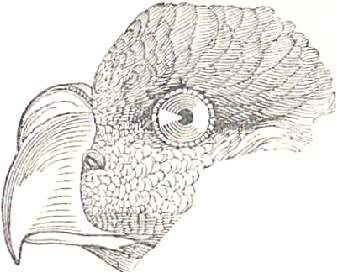
Picture of Crax genus of Curassow.

Picture of Curassow (Mitu genus)
|
The Curassow is the ordinary corruption
of Curacoa-bird, as the name was spelt in 1756 by Browne (Civil
and Natural History of Jamaica,
page 470), and doubtless due to the
belief that the birds of this kind which were first known to English voyagers
came from the island so called.
Dampier, a good authority on many things although
not on orthography, in 1699 and 1703 used Coresso
and Curreso
(Voy. ii part 2, page 67, and iii part 1, page 74);
Albin in 1738 wrote (N. H. Birds, ii page 29) of birds of this kind
(he having drawn illustrations of both male and female), "They are generally
brought from Carassow, from whence they take their name."
Sloane in 1707 (Voy. page 302) used Quirizao for both island
and bird; and Linnaeus in 1758 (Syst. Nat. ed. 10, i page 157)
used
Gallus curassivicus, which he professedly got from Aldrovandus.
He illustrated a species of Crax as Gallus Indicus (lib. xiv cap.
10).
The Curassows are the Cracinae subfamily
within the Cracidae family of birds (the only other subfamily within
the Cracidae family is the Penelopinae (chacalacas and guans)).
Within this Cracinae subfamily four genera were recognized
by 19th Century naturalists, Professor Huxley and Mr Salvin, and these
4 genera are still recognised today. The first of these is Crax
with a soft cere, and the nostrils placed in the middle of the maxilla,
while the remaining three have the whole of the bill horny and the nostrils
at its base, the lores being bare in Nothocrax, but feathered in
Pauxis (Cashew Bird) and Mitu (previously known as Mitua),the
former of which bears the curious frontal knob already mentioned, while
the latter has the culmen of its short and greatly compressed bill elevated
and swollen. Overall within these 4 genera there are a total of 14
species of Curassow.
The Cracidae are one of the most characteristic
families of the Neotropical Region, outside of which but few of them and
none of the Cracinae go, and are especially abundant in Central
and the north parts of South America, with a few being found in Paraguay.
The Curassow is similar in appearance to a turkey.
They have colourful ornamentation on the head. However, unlike turkeys,
Curassows build their nest in trees as they are arboreal birds. Generally
2 or 3 eggs are laid, which the female incubates for around 28 to 32 days.
They will come to the ground to forage for food.
Their diet includes fruits, seeds and berries as well as insects and small
animals.
These birds thrive well in confinement. Their
size and temperment mean that they can be aggressive and dangerous though.
They are particularly defenceful when guarding newly hatched chicks.
|





